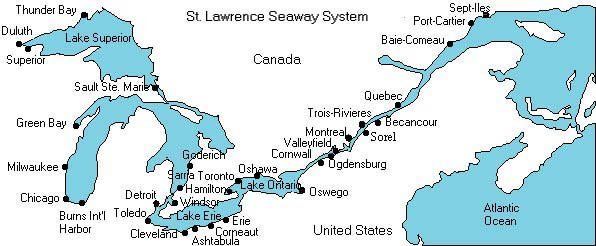Expedited Freight
- By Ontario Delivery
- •
- 28 Dec, 2018
- •
'Time sensitivity, that's the key right there.'

"Time sensitivity, that's the key right there," says Jensen, an OOIDA member from Cincinnati and senior field editor for Expediters Online. "Usually, in my experience, it's pick it up and go now. You've got to be there. I can't tell you how many times I've taken a load and had a forklift waiting there when I arrived. It's typical for anybody that's been in expediting."
He says a good example is the automotive industry. The line shuts down because of that one part they need. "They're paying people to stand around and look at a shutdown line," says Jensen, who now works full time for On Time Media and leases his truck to FedEx Custom Critical.
McCord, founder of On Time Media's Expediters Online web sites, lives in Florence, KY. He agrees that for truckers, time is critical. "Because of the time sensitive nature of the freight, every minute counts," McCord says. "It costs $16,000 for every minute that the plant is shut down waiting for those parts. It's mind boggling, especially to a driver hauling a box of widgets."
The evolution of expedited freight
The expedited freight industry started by hauling assembly line parts to automobile manufacturing plants, but has grown to hauling just about anything that will fit into a truck. If you need it now, they haul it. OOIDA members Mike and Gail Swiger say shippers and receivers have realized the value they're getting from expediters. As a result, the Swigers say expediters are hauling for a diverse cross-section of customers.
This Milwaukee husband and wife team hauled the first commercial satellite and a doctor's lifetime of cancer research, which had to be kept at a certain temperature so the experiments would not be ruined. Loads like these require the "white glove" treatment.
Mike and Gail regularly haul nuclear fuel rods for Westinghouse and General Electric. These nuclear projects keep them away from home for two or three months at a time. Admittedly, they are not on the road every day. Some days they spend in motels waiting for their next load.
Besides loads requiring special handling, expediters haul loads of all sizes and shapes. Jensen has hauled loads as small as an envelope or a computer chip to a ton of frozen egg whites in three-pound cans in a one-ton unrefrigerated van.
"I once hauled 10,000 softballs to a game just in time to be signed," says Jensen. He recalls a load of those rubber ducks so popular in river country for fundraisers. "I hauled 20,000 of those rubber ducks from Cincinnati to Louisville for a festival," Jensen tells. "They were loose and had to be shoveled in and out of the truck."
OOIDA member Joe Roman of Drummonds, TN, has also hauled some out-of-the-ordinary loads. During the Gulf War, he carried gloves from one military base warehouse to another for shipment to the Gulf. "Once I hauled three gallons of paint thinner that weighed 24 pounds," Roman says. "It was still a hazardous load because it was flammable."
Joe recalls another time he carried a bag of three bearings. "The bag weighed 1.5 pounds and I hauled it from Memphis, TN, to Batesville, AR. It was delivered to the maintenance department."
According to McCord, because expedited freight usually doesn't fill a semi trailer, expediters often drive Class 7 medium-duty trucks, six-wheelers and straight trucks.
"As the industry changes, drivers are investing more money in their trucks," he says. "You see them at truck shows with show-quality trucks."
McCord says he has noticed that truck manufacturers, including Western Star, Freightliner and Kenworth, are starting to show more interest in the production of medium-duty trucks.
"This industry has become a viable market for specialty trucks for expediting," McCord adds. "Major truck manufacturers are interested in what's going on in this business."
How they got into this industry
Unlike other trucking industry specialties, many expediters come from non-trucking-related careers into the expedited freight industry, according to McCord.
Joe Roman says he worked his way up from driving taxicabs to limousines, then courier vans, and finally expedited freight trucks. He went from hauling rocks stars, teen idols and international royalty to hauling parts for automobile manufacturing plants.
Roman began driving taxicabs and limousines in his hometown of Chicago to supplement his work as a freelance photographer for the Chicago Tribune and other area newspapers. Some of his more famous limo passengers included REO Speedwagon, Bruce Springsteen, celebrity photographer Toni Diorio, teen idol Shawn Cassidy, and the prince of Morocco. In addition to his photography, Roman owned a small music store and published the Chicago Musicians Journal for 10 months. Since he began hauling expedited freight in December 1993, Roman has contracted with the same company, Tri-State.
"Before [1993], I had never heard of expediting. I was driving a Pony Express Courier Corp. company van in Memphis," Roman says. "During a coffee break, I met a Tri-State driver that asked me if I was making any money. He showed me his settlement statement. I knew if he could do it, so could I."
Roman stayed with Pony Express until he accumulated everything he needed - a van, his CDL, a cell phone, pager and funds to start operating.
"Within my first six months in expediting, I developed my checking account to almost $11,000," Roman recalls. "I did it by accepting over 99 percent of my load offers."
The Swigers have been involved in the expedited freight hauling business for 11 years. They drive their Peterbilt 372 cabover truck for FedEx Custom Critical, which previously was Roberts White Glove.
Both Mike and Gail have spent 20 years in the trucking industry. Before they became expediters, the Swigers hauled hay on a flatbed truck in Wisconsin; produce to Kroger and Big Bear markets; merchandise for Sears; and show equipment for the Toro Co.
The business of expediting
One of the most talked about advantages of expediting is the pay. Lawrence McCord points out that a cargo van can make more money than an 18-wheeler, or about $1.25 a mile. The Swigers use their Auto Map mapping program on their laptop computer to verify the mileage of a proposed load. They divide the money by the number of miles, and if it comes up to $1.10 per mile they take the load.
Joe Roman takes a different approach to deciding whether to take a load or not. He says refusing a load is not something you can do on every load offer.
"If you've had two or three load offers with good mileage and close to your pickup, you can afford to take a lower paying load," Roman explains. "Consider what you've done for that month or year-to-date. If you bundle the loads together, everything averages out at the end of the year."
"Some people expect to make a ton of money in this industry because you get good rates per mile," Roman adds. "Some people expect to make $120,000 or more gross per year. Maybe one or two will."
"Some expect to make $2,000-$2,500 a week. That happens often. Some people expect $3,000."
Joe says that happens once or twice, maybe three times a year. "$1,500-$2,000 a week happens a lot, but most times it's $1,000-$1,500 week," he says, "and some weeks you only make $400-$800."
Roman has tracked his average length of haul at 367.49 miles. His statistics show he ran 40,057 loaded miles. His business, which includes a second driver, has combined gross earnings of $45,306.72, which averages out to $1.13 per mile. He explains that his paid miles, bonus miles and fuel surcharge are included in the gross earnings. Roman gets his statistic figures by using Quicken Deluxe 2000, which he says tells him everything he wants to know about his business.
Because expediters are owner-operators, they run their own businesses, often hiring additional drivers and building their own fleet. As a result, expediters have additional concerns about getting loads and driving. They must manage their business by keeping meticulous financial records, auditing their settlement statements and, often, processing payroll for their drivers.
Roman uses a payroll company to handle his settlement statements and pay his driver. "My settlement statement goes to them, they pay my driver, deduct driver's pay and their fee from my checking account, then I get my statement from Tri-State and the payroll company together," Roman says.
Joe says he doesn't want to be home every Thursday to get his settlement statement to figure out how much to pay his driver. "I'm not an accountant," he says.
The Swigers approach their business in much the same way. Their business is incorporated. "We receive a salary, and the company buys everything else," Gail says.
As with any business, expediting has its disadvantages. McCord explains that one disadvantage is that expediting is seasonal. "It's slow in winter months, and in July when the auto industry shuts down for retooling for the next model year," he says.
Joe Roman, on the other hand, has found a way to make use of this slow time. "When General Motors shuts down in July, lots of expediters take advantage of that time for truck repair, but that's the time when I find my non-automotive customers."
Advice for wannabes and newbies
"The length of haul runs from 250-400 miles, then you might wait a few hours or a few days for another load. You never know until the last minute because they don't know that the plant is going to break down."
-Lawrence McCord, founder of Expediters Online
"Whether you're trying to get into expediting or become an owner-operator, go into it with a used truck. It's not going to make you anymore money. Drive a used truck for two or three years, so you're not stuck with a $2,200 or $2,500 payment. Go into it smart. Don't front load yourself with those big charges. Take care of a 'good ole truck until you get your feet wet. Don't jump into it and think you'll get rich over night."
-Mike and Gail Swiger, FedEx Custom Critical
"The only guarantees in this industry are that the truck payment and the insurance premiums are due every month. No guarantees on how much you'll make, the types of loads, weight of the load, whether the load is hazardous materials or not, the direction it's going, and no guaranteed load offers toward home for the weekend.
"This industry will not tolerate a personal agenda. You cannot operate according to your own agenda. If you're close to home and get a load offer in the opposite direction with good mileage and pay, you can't just refuse it because you want to get home. The carrier's customer sets the flow of the freight.
"When you place yourself in service, you need to be ready to run with your logbook up-to-date and your pre-trip done.
"People can do well in this industry, but it's not a bed of roses."
-Joe Roman, founder of the "Expediter Forum"
"This forum (Joe Roman's "Expediter Forum") is one of the best sources of expediting info around because there are quite a few veterans of this business posting here, and they can offer valuable advice for the newbie. Over at ExpeditersOnline.com, I'm in the process of assembling a mini-guide for newbies."
-Jeff Jensen, field editor for Expediters Online
Expediters create solutions for information exchange
When company drivers take a coffee break in a truckstop, it's not unusual to run across another driver from the same company. They might even start up a conversation about a recent company event, or change in company benefits, or give each other tips on how to handle certain dispatchers or delivery sites.
Even two owner-operators contracted with the same company might have lunch together. But for expediters, there's often no such thing as a co-worker. You work for whatever company needs your services the most at any given time, and you rarely see another expediter in a truckstop.
With all the trucking industry publications in print, expediters have historically been challenged when it comes to finding information specific to their industry. In fact, some expediters have turned their information frustrations into online businesses.
Joe Roman receives credit from his peers for creating the first web site specifically for expediters. He admits his Expediter's Forum is a copy of TruckNet's Professional Drivers Round Table found at www.truck.net.
"With the support and encouragement from Monty Rhodes, the Round Table's administrator, to 'go for it,' I started www.jroman.com with its only feature being the Expediter Forum. I didn't want to fill this site with links that were not of specific interest to expediters, and I didn't want to duplicate the links that were already at Truck Net and Truck'n Tom's web sites."
After Roman wrote his original files, he asked Pat Bonanno at trucksonly.com to clean up his files and add a bulletin board. Since Bonanno didn't have a bulletin board program that included e-mail links for posted messages, Roman contacted Rhodes again.
"Monty introduced me to Rick Thompson at Oznet, which, up until recently was Truck Net's web host," Roman said. "He already had all the necessary directories and files in place because the original round table ran under www.board, created by Matt Wright."
Lawrence McCord has spent 12 years in the expedite industry. His truck is still leased to FedEx Custom Critical. He started ExpeditersOnline (www.expeditersonline.com) 18 months ago out of frustration with the lack of information in print for owner-operators in the expedite freight business.
McCord explains that he and his partners at On Time Media have created several expediter web sites and will be in print soon. On Time Media already e-mails a newsletter, "The Hot Shot," to expediters.
Expediters' Online field editor Jeff Jensen writes from his experience as an 11-year veteran expediter. He has seen the industry go from the basic title of 'just-in-time' freight to expedited freight.
"It's definitely a niche market," Jensen says. "You can take any segment of trucking, and each one totals many more than expediting as a whole."
He says the print media has not yet covered the industry. "You'll find very little, if anything at all, that is expediter specific," he says. "They just don't address the expediter's situation."
Jensen is quick to praise McCord for his accomplishments with Expediters Online.
"Lawrence McCord is a dynamo. He has taken the ball and run with it," Jensen says. "The financial backing is from On Time Media, but the concepts are his."
- Expediters Online (www.expeditersonline.com) is listed as "The Expediter Freight Information Center." This site provides valuable information and links for expediters.
- Expedite Now (www.expeditenow.com) is listed as "The Internet Magazine for the Expedited Freight Industry." This site includes news and feature articles about expediters and the industry.
Expedite Source (www.expeditesource.com) is listed as the directory for the expediting transportation industry. On this site, expediters find associations, communications, equipment, government resources, road and weather conditions, truck components, web sites, business information, carriers, freight services, health resources, news, software and truckstops.
Expedite Loads (www.expediteloads.com) provides load matching for the expedited freight industry.
Expedite Mail (www.expeditemail.net) offers expediters a free e-mail account.
Expediters Online Net (www.expeditersonline.net) is an Internet Service Provider for expediters.
Other good web sites for expediters
Express Trucking (www.expresstrucking.com) calls itself an information resource center for expediters. This site connects businesses and entrepreneurs in the industry, provides directors of truck manufacturers, equipment dealers and leasing companies, and offers business strategies and tricks of the trade.
Owner-Operator Independent Drivers Association (www.ooida.com) is important to expediters because they are owner-operators and many are OOIDA members. This site gives owner-operators updates on legislation, industry issues and news that affect them as owner-operators and drivers. Additionally, OOIDA's web site links to numerous web resources including: Land Line Magazine, the University of Michigan Transportation Research Institute, Interstate Highway Conditions, Road Watch America, The Federal Highway Administration, Commercial Vehicle Safety Alliance, PBS Tax and Bookkeeping Service, Drivers Daily Log Program freeware, Truck Net, Layover's web page, The Trucker's Helper Software, and Harvard Business Services, to name a few.
When the Swigers found little information for expediters, they looked for basic practical information from Land Line, Road Star and Owner-Operator magazines, and especially The Maintenance Council. Gail Swiger serves as the only owner-operator on The Maintenance Council along with engineers, freight executives, maintenance workers and supplier representatives. The Maintenance Council discusses and researches maintenance issues related to the trucking industry. Gail is the first vice chairman of the council's cabin control study group. Her study group looks at things that affect cab comfort like heating, air-conditioning and interior lighting.
All these expediters have proven that if you want information, you will find it. These professional expediters have gone one step further by getting involved in sharing their newfound information with other expediters through web sites, forums and trucking associations.

For energy levels, ability to do their jobs, fighting fatigue and all that, it is important,” says vice-president Doug Sutherland. “Multiple trades kept saying to us, ‘Where do I apply? I’m going to go get my Class 1 to work for you guys,”’ he adds, referring to those who were involved in the construction work. One employee of the moving company that helped the fleet relocate said that very thing, and is now in the midst of training for a licence. It’s just one example of the way health and wellness programs are emerging as a recruiting and retention tool. And no matter where a focus on healthy lifestyles begins, it seems to boost productivity and attitudes alike.
“Exercise has the same beneficial effect as almost anything doctor or psychiatrist could prescribe you for depression,” says Alfy Meyer, a 66-year-old Brampton, Ont. driver who spent 39 years driving across North America. These days he only hauls the occasional load for film crews, but the focus on a healthy lifestyle remains.
Sleep
According to Andrea Morley, nutritionist and health coach at Healthy Trucker in London, Ont., establishing a consistent pre-bedtime routine is the first step to a good night’s sleep. It could involve brushing your teeth and then reading a book for 10 minutes or watching 15 minutes of a TV show. “If you do the same things, it signals your body each night wind down for sleep,” she says. Meyer advises to do everything possible to go to bed at the same time you would at home.
Route planning will help, especially when it comes to finding the all-important parking space. “Most truck stops now are filling up long before 7 o’clock,” he says. Meyer finds that showering in the morning also helps to avoid evening lineups and make the most of available rest time. Once settling in, use every available curtain to block light and create a dark sleeping environment, Morley says. This could include aftermarket curtains to block the windshield and windows rather than simply drawing a sleeper compartment’s curtain, creating the largest-possible space in the process.
Sleep masks can block any remaining light, too. Then there’s the matter of enhancing the mattress that comes with the truck. “Chances are, you’re not being paired up with the exact mattress that you need,” Morley says, recommending a foam topper or an upgraded mattress.
Since silence can be tough to come by around other trucks, using a fan or other sources of white noise can help create a comfortable environment. There are actually white noise smartphone apps, Morley adds. Earplugs are another option if the noise continues to be bothersome.
It can also be a good idea to bring your own sheets, blankets and pillows from home. Just the familiar smell of your own bedding can be soothing. “Nobody sleeps well in a hotel, and when you’re sleeping in a truck five nights a week, it’s basically like sleeping in a hotel,” she says.
If finding a restful night continues to be tough, keeping a sleep journal can help to identify problematic patterns. Six to eight hours of sleep is a minimum, says Meyer. It’s one of the reasons he supports the stricter enforcement of hours of service through electronic logging devices (ELDs).
With that, drivers won’t feel as much pressure to cut into their sleeping hours, he says.
A light meal before bedtime will help as well. Says Meyer: “Nothing that sits heavy in your stomach.”
Nutrition
Not all trucking companies allow drivers to cook inside their trucks, because of possible lingering smells and cleanliness issues. But those who have the option can easily prepare healthy options. The choice of food for the sleeper’s fridge - even the packaging - has a role to play. Rectangular containers will optimize the limited space. And Morley recommends stocking fruits and vegetables when possible. “Things like canned tomatoes are awesome because they’re really versatile. They can be thrown in so many different types of dishes,” she says.
Apples and bananas also are healthy choices that can be kept at room temperature. If you are crossing the border, however, remember that lots of foods can’t be moved from one country to the other. The enforcement of such rules can be inconsistent, so Morley suggests that those who always use the same port of entry should ask for a list of allowed foods.
Essential onboard appliances to prepare the foods include a portable rice cooker that can be used to cook almost anything,and a hot plate, Morley says. “Say you want to cook a jambalaya with sausage and chicken and rice and tomatoes. You can easily do that in a rice cooker and that will take about 20 to 30 minutes,” Morley says. Even the compact rice cookers make it possible to prepare a couple of servings at a time. Meyer pleads for a quality microwave oven on top of that. Breakfast should be the most consistent meal of a driver’s day. It could be whole grain cereal with berries, bananas or honey in it; hard-boiled eggs brought from home; or microwaved eggs.
“I always recommend fruit as a snack for when you need energy because it will give you that boost of carbohydrates that your body and brain need to function. We want drivers to be focused, safe, alert and awake on the road, so fruit is a great option,” Morley says. They can be used to prepare quick, tasty smoothies, for example.
Granola bars are another healthy option for a snack. A driver can still eat meat, though. “Go ahead and eat meat. But don’t become a pig. Four to six ounces, whether it’s pork, beef or chicken,” Meyer advises, adding that a kitchen scale can be used at home when preparing portions for the road. Nuts of all kinds are also recommended, especially if they’re not salted, but processed foods such as cold cuts should be avoided. The numerous additives in them are particularly hard on the liver and kidneys.
Sugary cereals, bagels and muffins should also be in the “no-no” category, Morley believes. “They don’t offer a lot of nutritional value. They will spike your blood sugar in a bad way and then your blood sugar will fall very quickly and you'll become very tired and hungry after an hour or two, versus something like fruit that will sustain you for a little bit longer.”
The last meal of the day should be the lightest. Both Meyer and Morley suggest opening a small can of salmon, tuna or sardines, or tossing a salad with vegetables that are available.
Soup can also be a comforting alternative for dinner, too. But any form of caffeine - including energy drinks - is to be avoided, just like alcohol, Morley says. Water, milk or green tea are healthier options before going to sleep.
Physical Activity
Exercise also remains one of the best options to digest food and ensure proper sleep patterns. And it doesn’t have to be a high-impact workout. “Drivers are sedentary. They don’t get a lot of activity in their day-to-day routine,” Morley says.
But even walking around truck stops, or simple workouts that rely on bodyweight alone, can make a difference. “That’s a good way for drivers to improve their strength and challenge their muscles while they’re on the road.”
Jogging, which puts stress on the knees and hips, may not be the greatest idea in a trade that involves bouncing around all day in the cab. Meyer faces joint issues himself and enjoys a swim whenever he can find access to a pool. “If you’re not a swimmer, go in the shallow end and just walk against the water for 30-35 minutes,” he says, referring to the low-impact exercise.
Stretching is crucial to warm up muscles before any physical activity, and it’s also a great way to improve blood flow and increase alertness, which translates into improved safety behind the wheel. One easy stretch involves sitting on the bunk and stretching one leg out across the mattress. Then reach down along the leg until feeling a comfortable amount of stretching in the back or thigh. An added advantage to stretching is that it will relieve tension in the torso and arms after long periods at the wheel, too.
Meyer certainly warns against the bad posture that can lead to neck pain. Keeping your right hand on a vibrating stick shift can also lead to carpal tunnel syndrome, he warns. A quality seat with armrests, and lumbar and lateral sup port, will help address both issues.
Investments in healthy living will certainly help to ensure there are plenty of healthy miles to come.

The number of vessels currently in the Great Lakes-Seaway system had exceeded the five-year average at the season’s close just before December 30, as ships made a final push to export grain from Thunder Bay and other Ontario ports.
The 2015 St. Lawrence Seaway shipping season mirrored North American and global economic trends, said Terence Bowles, President and CEO of The St. Lawrence Seaway Management Corporation.
Across the board, total year-to-date (April 2 through November 30) cargo on the Seaway was 31.5 million metric tons, down 10.4 per cent.
“Domestic and cross-border transport of cement, stone, gypsum, aluminum and machinery continues full throttle in response to heightened construction activity and a strong automotive sector. While steep declines in global consumption and pricing have largely curtailed coal and iron ore exports, we are encouraged by the recent surge in grain exports, which once again demonstrates the vital role played by the Seaway in supporting global trading activity.”
New business has helped to offset shortfalls with figures from April 2 to November 30 showing that the St. Lawrence Seaway attracted 1.7 million metric tons of cargo either coming from new origins or heading to new destinations, said the Chamber of Marine Commerce.
“New terminal announcements in the agri-food sector are helping to reinforce the Port of Hamilton’s role as a grain hub, with increased grain handling capacity,” said Bruce Wood, President and CEO for Hamilton Port Authority.
“Construction-related materials like sand and stone have also been very strong this year, owing to continued population and infrastructure growth in Canada’s most populous region. Heading into the last weeks of the season, these commodities are trending 16 per cent higher than the previous year.”
After its own major infrastructure renewal program, Eastern Ontario’s Port of Johnstown has had a record performance this season with ships transporting 784,000 metric tons for the season up to November 30.
“This has been a stellar year,” says Robert Dalley, General Manager of the Port of Johnstown. “Overall cargo tonnage so far is up 20 per cent. We’ve seen increases in every category from road salt and aggregates to liquid bulk and breakbulk. Grain transported by ship jumped by nearly 50 per cent, due to U.S. corn coming in for local ethanol production. Project cargo, 26 containers of parts for a Napanee generating station, also arrived for the first time on our brand new 19-acre River Front dock. We also completed the $8.9 million restoration of our Harbour Front dock and this extra capacity will hopefully help us with continued growth next season.”
Port of Oshawa investment has also attracted new companies and convinced others to grow. A wholesale distributor of structural steel products has opened a new warehousing operation at the port, creating 30 new jobs. Construction was recently completed on a new 45,000-foot transit shed, which is in close proximity to the port’s new $4.1 million rail spur. “We’re very proud of what we’ve been able to accomplish over the past year,” says Donna Taylor, President and CEO of the Oshawa Port Authority.
Elsewhere, the Port of Toronto continued to see strong levels of imports including salt, sugar and aggregate. Sarnia Harbour has also performed well this season and is now preparing for winter layup.
“Grain volumes at the Cargill dock are between 700,000 – 750,000 metric tons, and we have had two over-sized machinery shipments that illustrate the potential for the Sarnia Harbour to become the terminus of a heavy haul corridor for the region’s manufacturing and petrochemical industries. We have 10 ships booked for winter layup and maintenance and that will help employ up to 300 people over the winter,” said Peter Hungerford, Director of Economic Development & Corp. Planning at the City of Sarnia.
“We are also seeing the rewards of new investment in Canadian ports and new vessels,” said Stephen Brooks, President of the Chamber of Marine Commerce. “During the past two weeks, that trend has continued with Algoma Central Corporation ordering two more vessels and Parrish & Heimbecker revealing a $40 million investment in a flour mill at the Port of Hamilton.”
Speaking at the H2O conference this November, Terence Bowles noted that shippers want door to door capability.
The Seaway is a 3700-km “marine highway” running from the Western tip of the Great Lakes to the Atlantic Ocean, with 41 ports on the system and handling $35 billion in economic activity.
Bowles spoke of the “challenging conditions” out there.
“We’re working hard to match last year’s performance. We are slightly below the five-year average. Overall grain is down somewhat from last year, still a good year across the average. Steel, iron ore, and coal face difficult times,” Bowles noted.
Construction activity is picking up, while liquid bulk is a market that varies but overall has had a pretty good year. Wind energy and specialized cargo projects are up.
“It’s important to press on and look at ways of expanding our market, to continue to improve our efficiencies. The only way to compete with other gateways is to have lower costs. I’m pleased with the fleet renewal program; new ships keep coming into our system,” Bowles said.
Bruce Hodgson, Director of Market Development, for St. Lawrence Seaway Management Corp., said Highway H20 is now up to 52 members with all segments of industry being represented.
Target audiences include European bulk and container shippers and breakbulk shippers.
Highway H2O is present at various trade exhibitions including Breakbulk Antwerp and Breakbulk Americas.
A new website will be launched soon, which is three-screen responsive, with refreshed branding, quicker loading, and easier navigation, he said.
Betty Sutton, Administrator, Saint Lawrence Seaway Development Corporation, said the Great Lakes “represents the world’s 3rd largest economy, 30% of US-Canada activity. We are here to assist the Great Lakes seaway ports, to be a trusted asset and dependable partner,” she said.
The SLSDC launched the Great Lakes opportunity belt initiative aiming to reach out to more and more dynamic audiences about the waterway.
“We recently brought the message to Capitol Hill about what we do, as well as to business groups. These outreach efforts have been a critical component of our development initiative. We need to work to take this program to a new level. How do we build on the many positive steps? How does the program add value-what would benefit you more to promote business potential and economic growth?” Sutton said.
Mark Parker, Partner, Metal Strategies, commented on the steel market and the resulting effect on Seaway traffic.
“A few years ago we had reason to believe that demand would pick up and the sector would return to growth. Now suddenly the outlook is flatter than what we had believed even a couple of years ago. Steel demand indicators are mixed. There is surplus steel capacity worldwide and profitability concerns that will put pressure on commodity prices. There’s been a downsizing in iron ore, and steel demand has fallen to 100 million tonnes per year annual basis. At the moment, 28% of the demand for steel is from the automotive sector. That’s a positive for steel demand moving forward,” Parker said.
Construction-related demand for steel is at 38% and Parker said we’re looking at about 3% growth expected over the next 5 years.
“Energy and industrial equipment demand, however, is falling and is offsetting the other growth. U.S. manufacturers have too much capacity-they are running at a rate of 77 % and that’s continuing to drop. Investment in equipment is flat. Energy related steel demand will be down 60% this year,” Parker noted.
Reasons to be hopeful? U.S. oil production is still double what it was in 2008 because of shale.
“They are making investments in the viability of it. Shale oil and gas suppliers are now the ‘swing suppliers’. It’s easy to set up and take down a rig. That ability to shut down capacity so quickly is why we’re seeing steel demand drop so steeply,” Parker noted.
Two other factors clobbering the steel industry right now are import competition are excess capacity in steel worldwide.
Turkey and Russia are key suppliers whose currency has plummeted.
“China, the largest supplier, will be the wildcard that will continue to put pressure on the market. U.S. steel mills are running at only 70% capacity rate. China is operating at half its 1.2 billion capacity and could in theory supply virtually all demand outside its borders. It has small projects that could be coming on board there and it’s going to export its way out of trouble,” he said.
In Canada there will be no meaningful growth in steel demand over the next five years.
Iron ore will see some demand over the next year because the scrap supply is tight but after that demand will be flat to low.
“With the strong U.S. dollar it would be cheaper to import iron ore. The Canadian dollar is low which should help but the leading suppliers, Australia and Brazil, have faced currency depreciation so as a result, these producers will be more competitive than their North American competitors,” Parker said.
“Even though car production will grow 3% you are looking at (increased use of) alternative products, to reduce weight. With high strength low allow steels, a 30-50% drop in steel use in cars is possible in future. The real pressure in capacity reduction has to be outside North America,” he said.
Competitive comparisons
How does the Seaway stack up against other gateways?
Cost is the primary driver of bulk/breakbulk shipper routing decisions.
“Seaway routings are very cost advantageous for many trades,” Roy said. He cited as examples iron ore from Labrador to the Great Lakes markets, steel slabs from Europe to the Great Lakes markets, and manufacturing steel from the Great Lakes markets to Europe.
“The basic message is Seaway competitiveness is relatively safe, aside from the fact that we are captive to what is happening in global economies. Following up from last year on the potential proposal of moving project cargo, we’ve since had the chance to look at that and found the Seaway more competitive than most think. There is a cost advantage vs. Houston for pipe, nacelles, turbines, and mining trucks from Illinois to Western Europe.
In some cases, competitiveness is close to the margin.
“The competitive cost advantage for other modes is in some cases very slight so changing the balance could help attract more business. What could change the landscape? Pilotage rates, ballast water requirements, Coast Guard navigation,” Roy said.
A 2012 competitiveness study offered some recommendations for the Seaway, Hodgson said.
“Some specific commodities were identified as potentials: pet coke, met coke, project cargo. The number one criteria shippers tell us is there is no service-not enough vessels. The Seaway needs to do a better job of establishing mechanisms and relationships to package and sell the entire Seaway routing, to promote and make available information about Seaway routing options and related competitiveness,” he said.
The study encouraged rate flexibility among transport chain partners to promote the Seaway routing’s competitiveness, and the facilitation of the consolidation of project cargo to promote the establishment of liner services.
“Can we incentivize more carriers to come into the system? Deep dives in the market research team were done on pet coke and its main traffic flows. Research has shown we are competitive and positioned for opportunities in the long term. With regard to the load centre consolidation initiative, the Seaway is found to be competitive with Houston and other centres, with a minimum of 5% advantage. There is a lot of project cargo from the U.S. Midwest to Houston that is being put on rail. We would have a huge cost advantage putting it on a vessel. The major challenge is a lack of capacity,” Hodgson said.
The Seaway has had a business incentive program in place since 2008, offering 20% reduction on tolls for cargo qualified as new business.
The program has been gaining in terms of popularity with 1.42 total new tonnes and $2.54 million in total new revenue from 2014 to 2015.
It’s about simplifying the system, he noted.
“The myth is that the Seaway is a complicated system-we know it’s not but we have to get that message out into the marketplace. We’re putting a concentrated effort on showcasing how the Seaway can save time and money. We have put in one direct number for shipping inquiries. That information is then passed on to stakeholders as required.”
The Seaway’s volume rebate incentive program offers a 10% refund on cargo tolls applicable to incremental volumes meeting a set of criteria, while its service incentive offers a reduction of 20% on applicable cargo tolls for carriers that implement a new service.
Towards a Mid-America freight coalition
Ernie Perry, PhD, with the University of Wisconsin in Madison, runs the Mid-America Freight Coalition.
Comprising 10 states, the coalition represents 22% of the U.S. population, 23% of the country’s total truck tonnage, and 63% of its total rail tonnage.
“There is a broad range of areas or systems we can work in to increase our competitiveness, such as looking at marine highways as corridors, that they need to be collaboration efforts, they need to be leaders.”
The Coalition aims to identify opportunities to collaborate, and to increase awareness of and commitment to freight plan activities across the participating states, and to identify and share best practices across all areas of freight planning and development.
“We’re in a situation where we have to use all the systems,” Perry said.
Ballast water discharge
David Reid, PhD, Consulting Scientist with the Saint Lawrence Seaway Development Corporation, said that 44 countries have signed the IMO convention on ballast water discharge standards, but there is concern over the robustness of G8 testing protocols, and over the reliability of original G8 type approved systems.
A report proposed revisions to G8, including wider temperature and salinity ranges, fresh water redefinition, and more.
“Evaluating compliance in the field is the preferred method, though you can’t go down to a certain level of examining waste, so you look at ‘gross exceedance’. In the U.S., the legal/policy arena remains unstable. Science based improvements to the testing policy and regulations are being incorporated, and alternative approaches and advancements in technology are being evaluated.”
We are closer to harmonizing IMO and U.S.- type approval processes. Practical limits for immediate compliance testing are being recognized and alternative measures are being assessed, he said.








